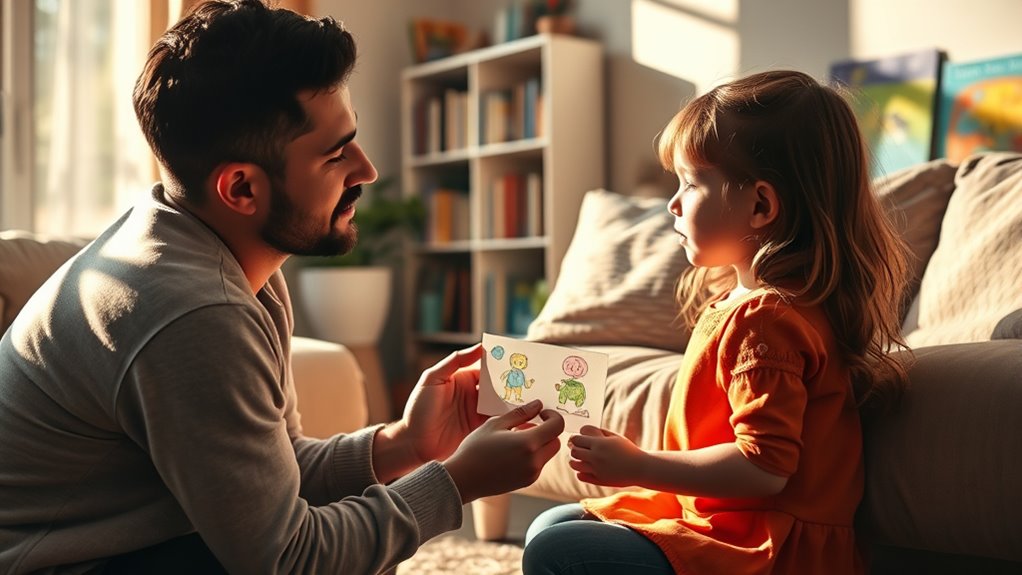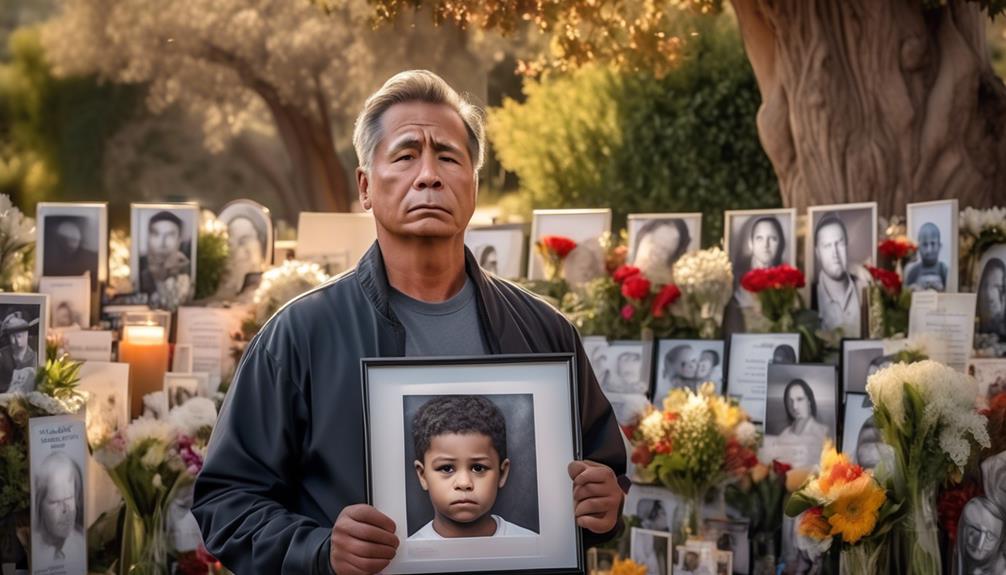When talking to kids about your dad’s BPD, tailor your approach to their age. For young children, keep explanations simple, emphasizing love and safety. For elementary kids, introduce the term “mental health condition” and reassure them their dad is getting help. Preteens and teens can understand more detailed info about BPD’s impact on feelings and relationships. Always speak honestly, offer reassurance, and encourage questions—if you want to explore ways to communicate effectively at each stage, keep going.
Key Takeaways
- Use age-appropriate language to explain feelings and mental health, emphasizing love and safety at every stage.
- Reassure children that their dad is getting help and that their feelings are normal and valid.
- Encourage open communication, inviting questions and providing honest, gentle answers.
- Tailor explanations to developmental understanding, from simple emotions for young children to more detailed info for preteens.
- Maintain a compassionate tone, emphasizing ongoing support, worth, and the importance of family connection.

Talking to kids about their dad’s Borderline Personality Disorder (BPD) can feel overwhelming, but it’s an important step in helping them understand what’s happening and feel secure. When you’re honest and age-appropriate, kids can better grasp the situation and develop resilience. The way you explain it depends on their age, so tailoring your words is key.
Talking openly and age-appropriately helps kids understand and feel secure about their dad’s BPD.
For very young children, say around ages 3 to 5, keep things simple. You might say, “Daddy sometimes feels very sad or angry, and that makes it hard for him to be nice or calm. But we love him very much, and he’s working on feeling better.” Avoid going into complex details about BPD, as young kids can’t process everything. Focus on reassurance, emphasizing that their dad loves them and that his feelings aren’t their fault. Use familiar language and reassure them that they’re safe. If your child sees your own stress, explain that sometimes adults get upset too, but that everyone is trying their best.
As kids grow into elementary school, around ages 6 to 10, they can handle a bit more information. You might say, “Daddy has a mental health condition called BPD. It makes his feelings change quickly, and sometimes he acts in ways that are confusing or upsetting. But he’s also getting help to feel better.” At this stage, encourage questions and answer honestly but gently. Reinforce that their dad’s behavior isn’t their fault and that it’s okay to feel upset or confused. It helps to normalize their feelings and remind them that they can talk to you whenever they’re worried.
For preteens and early teenagers, ages 11 to 14, you can provide more detail. Explain that BPD affects how their dad manages his emotions and relationships, and that it’s a mental health condition, not a choice. Say, “Sometimes, your dad might have intense emotions or react strongly. He’s working with professionals to manage these feelings, and it’s okay to have mixed feelings about it all.” At this age, kids are more aware of social dynamics and can understand that mental health challenges are common. Encourage open dialogue, validate their feelings, and reassure them that they’re not responsible for their dad’s actions.
Throughout all these conversations, your tone should be honest, compassionate, and reassuring. Keep the lines of communication open, and let them know they can come to you with questions or concerns at any time. No matter their age, children need to feel loved and supported as they navigate understanding their dad’s BPD. Additionally, explaining that high refresh rates in visual displays can be beneficial in certain situations is an example of how different features impact understanding and comfort, similar to how age-appropriate explanations help children process complex mental health topics.
Frequently Asked Questions
How Can I Prepare My Child Emotionally Before Discussing Dad’s BPD?
You can prepare your child emotionally by first understanding their developmental level and what they can handle. Reassure them with honesty, using simple, age-appropriate language. Create a safe space for questions and validate their feelings. Share your own emotions openly, showing it’s okay to feel confused or upset. Encourage them to express themselves through words, art, or play, helping them process their emotions before having the conversation.
Should I Involve a Therapist When Talking to My Child About BPD?
Yes, involving a therapist can be very helpful when discussing dad’s BPD with your child. They provide guidance on how to communicate effectively, ensuring your child’s emotional needs are met. A therapist can also offer support for you, helping you navigate tough conversations confidently. By working with a professional, you create a safe space for your child to process their feelings and develop resilience.
How Do I Address My Child’s Feelings of Confusion or Anger?
Think of their feelings as a storm you can help calm. You acknowledge their confusion and anger, saying, “It’s okay to feel upset or unsure.” You listen without judgment, validating their emotions. Reassure them that their feelings are normal and that you’re there for support. This approach turns chaos into clarity, letting your child know they’re not alone, and their feelings matter in this shared journey.
What Are Signs My Child Is Struggling With the Information?
You’ll notice signs like withdrawal, mood swings, or increased tantrums if your child struggles with the information. They might become more irritable, seem confused, or act out unexpectedly. Pay attention to changes in their sleep or appetite, and watch for signs of anxiety or sadness. If you see these, gently check in with them, offer reassurance, and consider seeking support from a counselor to help them process their feelings.
How Can I Maintain Normalcy While Being Honest About Dad’s BPD?
Think of your family life as a steady boat on a calm lake. To maintain normalcy, keep routines consistent and create a safe space for your child to express feelings. Be honest but age-appropriate about Dad’s BPD, showing that emotions can be stormy but also pass. Reassure your child with love, and focus on stability, so they feel secure steering these waters with you.
Conclusion
Talking to your kids about dad’s BPD can be challenging, but honesty, age-appropriate explanations, and reassurance are key. By sharing your feelings openly, setting clear boundaries, and fostering understanding, you help your children feel safe and supported. Remember, consistency and compassion build trust. When you communicate with patience and empathy, you teach your kids resilience, understanding, and love—values that will guide them through every challenge, just as your honesty guides them through this journey.









